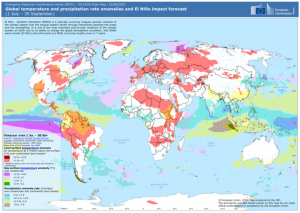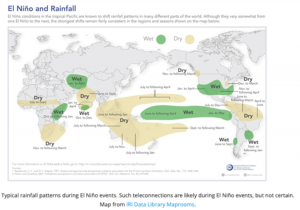
The World Meteorological Organisation has announced the presence of El Niño conditions in the tropical Pacific, for the first time in seven years. The WMO predicts a 90% chance of moderately strong El Niño conditions persisting in the second half of 2023.
El Niño is a phenomenon that occurs when the Pacific Ocean becomes warmer than usual. It has major implications for global weather and climatic patterns. El Niño leads to droughts in certain regions and cause floods in some others. It can disrupt farm production and also help the spread of pests and diseases.
The impact of El Niño on a global scale is substantial. In Australia, Indonesia, and parts of Africa, it can lead to droughts, crop failures and food shortage. In South America, the Philippines, and several parts of the United States, it can trigger floods that displace people. El Niño impacts weather patterns, triggering extreme events such as heat waves, droughts, floods, and hurricanes.


The onset of El Niño is reminder of the importance of climate change adaptation. Governments must prepare for the consequences of extreme weather events caused by climate factors. This entails developing contingency plans, monitoring El Niño’s development and potential impacts, and raising awareness among the public and decision-makers.
The advent of El Niño underscores the need for immediate action for climate change mitigation. Climate change amplifies the intensity of extreme weather events. Substantial efforts are needed to bring down greenhouse gas emissions and to mitigate a climate crisis.
The onset of El Niño poses a serious threat to several countries across continents. However, it also presents an opportunity to promote awareness regarding the necessity of climate change adaptation and mitigation. Concerted action by world nations can minimise the impact of El Niño and other climate-related risks, and foster a more resilient future for humans.
READ I Digital Personal Data Protection Bill gets Cabinet nod amid privacy concerns
Impact of El Niño
Rise in sea level: El Niño can lead to rising sea levels in certain regions and declining levels in others, significantly affecting coastal communities.
Changes in precipitation: El Niño can induce alterations in precipitation patterns, resulting in increased or decreased rainfall in specific areas. This can profoundly impact agriculture and water resources.
Changes in storm activity: El Niño can heighten the frequency and intensity of storms such as hurricanes and typhoons, causing devastation for coastal communities.
By taking prompt action, we can diminish the risks posed by El Niño and other climate-related hazards, ultimately establishing a more resilient future for everyone.
El Nino impact: The fear of unknown
El Niño, a significant mass of warm water currently spreading across the Pacific Ocean, has garnered extensive attention as it poses a threat to millions of people. It leads to a rise in global average temperature, alters rainfall patterns, and triggers extreme weather events.
In theory, El Niño may lead to colder and frostier winters in northern European countries, while making the southern regions wetter. The prospect of evenly distributed rainfall across arid lands would be a welcome change.
However, in practice, the rapid pace of global warming and the ongoing reduction of Arctic ice introduce uncertainty. The exact boundary between cold and dry conditions versus warmer and wetter ones remains unclear. Britain, situated roughly in the middle, could experience a combination of these effects.
At present, the magnitude of El Niño is still unknown, as it depends on measurements of Pacific warmth and its duration. Therefore, despite our extensive forecasting knowledge and computational capabilities, we can only observe and await the unfolding of events. Unfortunately, there is a sense of apprehension that some effects will be extreme and highly detrimental.

